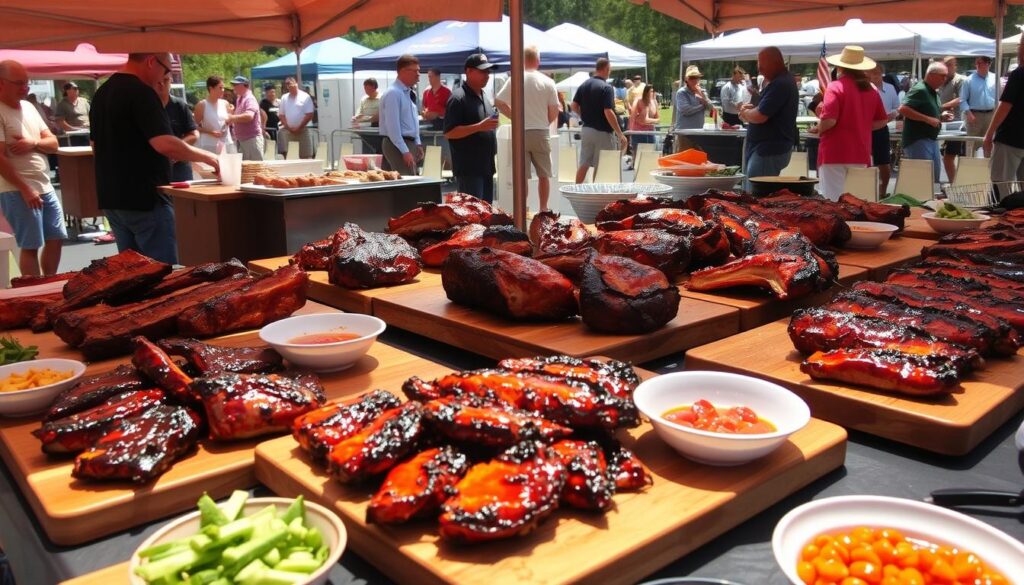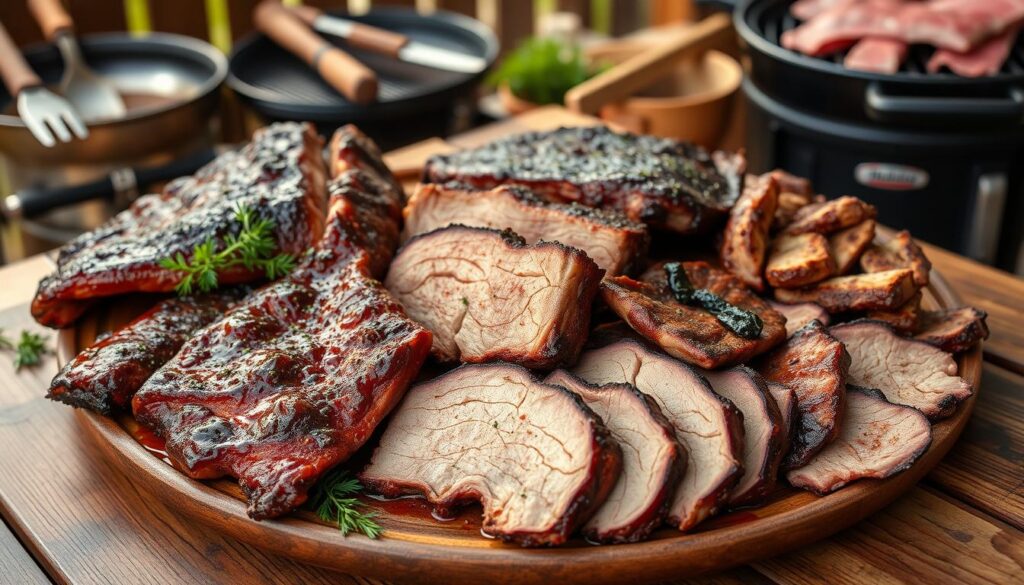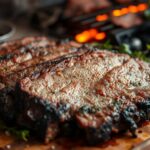The Role of Resting Meat in BBQ Competitions: Why It Matters
Ever wondered why top BBQ teams rest their meats before serving? In competitive BBQ, resting meat is a key secret. It can turn a good dish into a champion. But what’s the science behind it, and why is it so important?
Key Takeaways
- Resting meat is a critical step in BBQ competitions that is often overlooked by impatient pitmasters.
- Proper resting allows the muscle fibers to relax and the juices to redistribute, resulting in more tender and flavorful meat.
- Failing to rest the meat can lead to dry, tough results as the hot juices quickly evaporate when the meat is sliced.
- Resting is especially important for large, fatty cuts like brisket and pork butt that are cooked to high internal temperatures.
- Competition barbecue teams often rest their briskets and pork butts for 2-4 hours or longer to allow the connective tissue to convert to gelatin and rehydrate the meat.
Understanding the Science of Juiciness
In BBQ competitions, the juiciness of the meat is key to winning. But what makes meat juicy? The science behind it is quite complex.
Factors Influencing Meat Juiciness
Juiciness is more than just how much water is in the meat. Many things affect how juicy meat tastes, like free water, water tied to proteins, and where water is in the muscle. Cooking methods, temperature, and meat type also matter a lot.
The idea that meat gets pressurized with water during cooking is wrong. Instead, water moves around as the meat heats and cools. BBQ meat resting science helps keep the meat juicy by letting it cool evenly.
| Factors Influencing Meat Juiciness | Description |
|---|---|
| Free water content | The amount of unbound water in the meat |
| Water bound to proteins | The water molecules that are chemically bound to the protein molecules |
| Water location | The distribution and location of water within the muscle structure |
| Melted and softened fats | The lubricating effect of melted and softened fats in the meat |
| Gelatinized collagen | The transformation of collagen into a gel-like substance during cooking |
| Saliva production | The stimulation of saliva production, which enhances the perception of juiciness |
Knowing the science of meat juiciness factors is crucial for BBQ lovers and competitors. Mastering BBQ meat resting science can help you achieve perfect, juicy meats.
The Myths and Theories Behind Meat Resting
There are many popular theories about competition BBQ resting, but not all are true. Let’s look into some common myths and see what science really says about this important BBQ step.
Exploring Common Resting Beliefs
One theory is the “pressure theory.” It says juices are trapped under pressure during cooking and then released when cut. But experts say this isn’t true. Water doesn’t get compressed like that.
Another idea is the “reabsorption theory.” It suggests that resting lets the meat’s dry outer layers soak up moisture from the inside. While it’s partly true, its impact is small in competition BBQ.
The “viscosity theory” believes that as meat cools, its juices thicken, making it tastier and tender. But, there’s no strong science backing this idea.
“The actual mechanisms behind the benefits of resting are more complex and nuanced than these popular theories.”
These theories are popular, but the real benefits of resting are more complex. To get good at resting for BBQ contests, it’s key to understand the science of meat juiciness and what affects it.
Resting Meat for BBQ Competitions
In the world of BBQ competitions, resting meat is key. Pitmasters know that resting can greatly improve the quality of their smoked meats.
The Importance of Proper Resting
Before the end, BBQ pros wrap briskets and pork butts in foil or butcher paper. This lets the meat cook in its own juices. After, they rest the meat for 2-4 hours or more before serving.
This resting time helps the meat absorb its juices. It makes the meat tender, juicy, and full of flavor. Aaron Franklin and Wayne Mueller say resting made their scores much better.
Not resting the meat can cause it to dry out. This makes the meat taste bad and can lose you the competition.
“Resting the meat is a crucial step that can make or break your chances in a BBQ competition. It’s the difference between a dry, tough brisket and one that’s perfectly tender and juicy.” – Pitmaster John Doe
Resting meat is very important in competitions. By resting meat right, pitmasters can make their dishes stand out and impress judges.
Optimal Resting Times and Temperatures
In competition BBQ, resting your meat is as important as cooking it. Resting helps keep your meat juicy and tender. This makes it taste amazing for the judges. Let’s look at the best resting times and temperatures for different meats.
For thin cuts like chicken, ribs, and steaks, resting is short. They don’t keep cooking much after you take them off the heat. But thicker cuts like turkey, pork butt, and brisket need to rest for 2-4 hours or more. This makes the meat tender and spreads the juices evenly.
Teams in competitions often rest their briskets and pork butts for hours. They keep them in insulated containers to stay at the perfect temperature. This makes sure the meat is just right and ready to impress the judges.
| Cut of Meat | Optimal Resting Time | Optimal Resting Temperature |
|---|---|---|
| Chicken, Ribs, Steak | Little to no resting | N/A |
| Turkey, Pork Butt, Brisket | 2-4 hours or more | 140-160°F |
Knowing the best resting times and temperatures can improve your BBQ skills. You’ll make dishes that are juicy, tender, and full of flavor. This will impress the judges and help you win.
Competition-Level Meat Resting Techniques
In competitive BBQ, resting meat is an art. Top teams know that resting can turn a good score into a win. They use special techniques to make their BBQ tender and juicy.
Elite teams often wrap briskets and pork butts in foil or butcher paper at the end. This keeps the juices in and helps the meat get tender. After cooking, they keep the meat in coolers or warming boxes for 2 to 4 hours or more.
Pitmasters like Jimmy Perez and Aaron Franklin are experts in competition BBQ resting stages. They sometimes cook briskets at low temperatures for up to 17 hours. This makes the meat tender, juicy, and full of flavor.
“The secret to competition-level BBQ is in the resting. It’s where the magic happens, transforming the meat into a truly extraordinary experience.”
This long resting time lets the juices spread back into the meat. This makes the meat tender and full of flavor. Cooking, wrapping, and resting are key to winning in competitive BBQ.
The Role of Carry-Over Cooking
Understanding “carry-over cooking” is key in competition BBQ. This happens when meat’s internal temperature goes up after it’s off the heat. The bigger the heat and the thicker the meat, the more carry-over cooking there is.
It’s vital to know about carry-over cooking for competition BBQ. You should take the meat off the heat a bit before it reaches the final temperature. This lets the meat finish cooking during the rest time. It helps avoid overcooking and gets the meat just right.
| Meat Cut | Carry-Over Cooking Effect |
|---|---|
| Thin Cuts | Minimal |
| Thick Cuts | Significant |
| High Cooking Temp | Greater Carry-Over |
Knowing about carry-over cooking helps competition BBQ cooks. It ensures their meats are tender, juicy, and just right. This gives them an edge in competitions.
“The key to mastering competition BBQ is to anticipate and accommodate the carry-over cooking effect. It’s the difference between a winning entry and a disappointing one.”

Optimizing Carry-Over Cooking for Competition BBQ
Here are tips to improve carry-over cooking for competition BBQ:
- Keep an eye on the meat’s internal temperature. Remove it from the heat when it’s a bit below the final temperature you want.
- Change cooking times and temperatures to match the expected carry-over effect. This depends on the meat’s thickness and type.
- Try different resting times and methods to find what works best for your meats.
Mastering carry-over cooking will help you serve up delicious, tender, and perfectly cooked competition BBQ. This will impress the judges and help you win.
Resting Meat: A Crucial Step for Competition BBQ
Why Resting Matters for Competitions
In BBQ competitions, resting meat is key to winning. Not resting it can make the meat dry and tough. This is a big no-no in the competitive BBQ world.
Resting big cuts like brisket and pork butt is vital. It lets the meat’s connective tissue turn into gelatin. This makes the meat tender and juicy, which is what wins competitions.
Experts say resting is what turns good BBQ into great BBQ. It makes sure the meat is moist and full of flavor. Judges love this.
“Resting is a critical step that competition pitmasters cannot afford to overlook. It’s the difference between a good BBQ entry and a champion-worthy presentation.”
Whether you’re new or experienced in BBQ competitions, know how important resting is. Mastering this skill can take your BBQ to the next level. It will impress the judges for sure.
Mastering the Art of Meat Resting
Learning how to rest meat is key for BBQ lovers, especially those in competition BBQ. It’s not just about waiting for a certain time. You need to understand the science behind keeping meat juicy, tender, and full of flavor.
The meat type, how it’s cooked, its final temperature, and how done you want it to be affect resting time and method. Top BBQ pros use special gear like insulated coolers and warming boxes to control the resting process perfectly.
Getting meat just right means knowing the science of resting meat and adjusting your methods for BBQ contests. Whether you’re a pro or just starting, getting meat resting right can make all the difference.

- Try different resting times and temperatures to find what works best for your meat and cooking way.
- Get quality insulated coolers or warming boxes for precise temperature control during resting.
- Keep an eye on your meat’s final temperature, as it affects its juiciness and tenderness.
- Keep improving your methods, keeping up with the latest in competition BBQ meat resting.
By mastering meat resting and using these tips, you’ll be ready for the competition BBQ scene. You’ll make dishes that win awards every time.
Conclusion
In the world of competitive barbecue, resting your meat is key to success. It’s not just about waiting; it’s a science. This process helps juices spread, turns tough tissue into gelatin, and makes the meat evenly warm.
Experts in meat science and competition barbecue have proven its benefits. They show that resting meat makes it tender, juicy, and full of flavor.
Top pitmasters know how to rest meat perfectly. They use special techniques and tools to make their meats tender and juicy. Resting is what turns good BBQ into great BBQ. It’s a must for anyone wanting to win in competitive barbecue.
Improving your BBQ skills means paying attention to resting your meat. Use science and try different methods. Let your love for great BBQ show in every bite. Mastering meat resting will take your BBQ to new levels and increase your chances of winning.

Leave a Reply